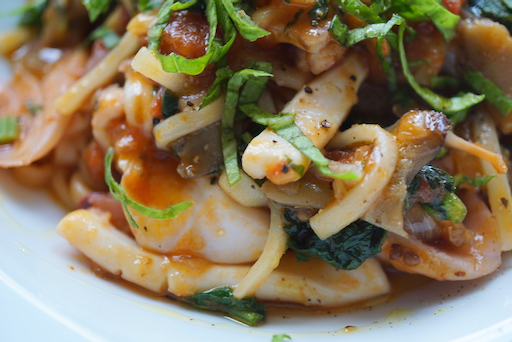I ordered fresh whole squid from Hmart via the Instacart. Since there was a minimum of 1 pound for the order so I specified 1.5 pound to be safe. I was expecting one large intact squid. Instead I got a substitute; "cleaned and packaged" squid. Since this squid did not include innards 1.5 pounds translated into quite a lot of squid; three large packages, much more than I expected. When my wife unpacked the bag she commented, "That's a lot of squid!" Since it was "cleaned" it was also more expensive per pound. I was thinking the body portion of the squid I bought would be intact so I could either stuff it or cut it into squid rings to fry. But the body portion had been opened to remove the innards. (Removing the innards even if the body has not been opened is not that hard and is what I do to prepare squid). In addition the thin skin (which is very hard to remove) and the small wings at the top were still attached. This all made it relatively easy for the person packaging the squid but not necessarily the customer left with the harder part of the prep. What I would have preferred is the body left intact but the thin skin and wings removed. Oh well, I kvetch.
I set to work and removed the wings ("enpera" エンペラ in Japanese. Supposedly, this word originated from "emperor" since the shape of the wings resembled Napoleon's hat) and removed the thin skin using a paper towel to grasp the edge of the skin and peeled it off. Most importantly, the good news was that the squid was fresh (i.e. no smell). It was much fresher than anything we would get from Giant. It was a fairly good size with tentacles so overall I was pleased.
I quickly boiled the tentacles in salted water with a splash of sake. (We enjoyed these as appetizers for several evenings with cucumber and wakame seaweed dressed in "sumiso" 酢味噌 vinegar miso dressing). I shallowly scored the body in crisscross fashion and cut it into one inch by a half inch rectangles. I used about a third of the prepared squid for squid in tomato sauce "udon" pasta. The rest I froze. This was lunch on Saturday.
Ingredients:
1/2 lb squid, body, cleaned, thin skin removed, apply crisscross shallow cuts on one side and then cut into 1 x 0.5 inch rectangles (see picture below).
1/2 cup marinara sauce (This was my usual homemade)
Cooked pasta (I used cooked udon noodles)
4-5 fresh basil leaves, cut into chiffonade,
Garlic, finely chopped (optional)
Salt and black pepper
Olive oil
Directions:
Add the olive oil in a frying pan on medium flame. Add the garlic (if using) and stir for 1 minutes or until fragrant. Add the squid and sauté for 30-40 seconds, add the noodle and the marinara sauce. Stir and warm up for few minutes. Garnish with the basil and splash good olive oil.
This was a good pasta dish. The squid was not chewy at all.

































